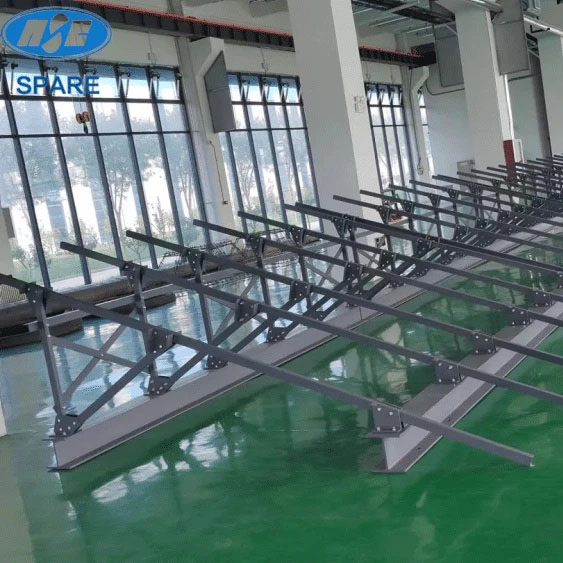- FRP Cable Tray System
- FRP Connectors
- FRP Handrails And Fences
- FRP Moulding
- FRP Pultruded Grating
- Residence Building
- Tool Handle
- Cooling Tower Structure
- FRP custom products
- Bridge Structure components
- FRP photovoltaic support
- Structural Component Applications
- Decking and Planting
- Decking and Planking
- FRP Assemblies
- FRP Decking and Planking
- FRP Building reinforcements
- FRP Structure shapes
01
Light weight and high strength alternative to metal materials FRP photovoltaic mount
Photovoltaic Bracket Test Instructions Simple Diagram of the Bracket
Simple Diagram of Panel Laying

Stand Size Description
A The length of the main beam is 5.5 m. a span between a1 and a2 is 1.35 m. b secondary beam length 3.65m. The span between b1 and b2 is 3.5m (minimum span). The main beam is on the uppermost level and the secondary beam is on the second level. The recommended profiles are 90*40*7 for the main beam and 60*60*5 for the secondary beam. Four 1.95m*1m PV panels are placed on the frame composed of a1, a2, b1 and b2. a3, a4, b1, b2 composed of four 1.95m * 1m photovoltaic panels on the frame. The weight of each PV panel is 30kg, the total weight is 240kg, considering the wind load, the bracket should carry 480kg weight. The connection between the main beam and the secondary beam can be fixed by simple nuts.
Simple Diagram of the Bracket


Simple Diagram of Panel Laying

Stand Size Description
A The length of the main beam is 5.5 m.
a span between a1 and a2 is 1.35 m.
b secondary beam length 3.65m.
The span between b1 and b2 is 3.5m (minimum span).
The main beam is on the uppermost level and the secondary beam is on the second level.
The recommended profiles are 90*40*7 for the main beam and 60*60*5 for the secondary beam.
Four 1.95m*1m PV panels are placed on the frame composed of a1, a2, b1 and b2.
a3, a4, b1, b2 composed of four 1.95m * 1m photovoltaic panels on the frame.
The weight of each PV panel is 30kg, the total weight is 240kg, considering the wind load, the bracket should carry 480kg weight.
The connection between the main beam and the secondary beam can be fixed by simple nuts.
Product Description Photovoltaic mounting systems are available in a variety of designs, including ground mounting, roof mounting and tracking systems, to accommodate different installation scenarios. The advantages of photovoltaic mounting systems are many. They provide a stable and durable foundation for solar panels, ensuring their longevity and effectiveness.
Additionally, these systems are designed to withstand harsh environmental conditions, such as strong winds and heavy snow loads, while also being corrosion-resistant. Photovoltaic installation systems have a wide range of applications in both residential and commercial settings. In residential installations, roof-mounted systems are often used, providing a space-saving and aesthetically pleasing solution. Ground mounted systems are often selected for large commercial and utility projects where space and land use are important considerations. Tracking systems, on the other hand, enhance energy production by following the sun's path throughout the day.
These systems are typically manufactured from high-quality materials such as aluminum and stainless steel, providing excellent structural integrity and weather resistance. The choice of materials ensures that the mounting system is lightweight and easy to install, while also offering exceptional strength and longevity. With their versatility, durability and performance, photovoltaic installation systems are key components in the efficient use of solar energy.
Overall, photovoltaic mounting systems play a key role in the successful deployment of solar systems, providing strong support for photovoltaic modules and enabling efficient solar power generation in a variety of applications.
Photovoltaic mounting systems are available in a variety of designs, including ground mounting, roof mounting and tracking systems, to accommodate different installation scenarios. The advantages of photovoltaic mounting systems are many. They provide a stable and durable foundation for solar panels, ensuring their longevity and effectiveness.
Additionally, these systems are designed to withstand harsh environmental conditions, such as strong winds and heavy snow loads, while also being corrosion-resistant. Photovoltaic installation systems have a wide range of applications in both residential and commercial settings. In residential installations, roof-mounted systems are often used, providing a space-saving and aesthetically pleasing solution. Ground mounted systems are often selected for large commercial and utility projects where space and land use are important considerations. Tracking systems, on the other hand, enhance energy production by following the sun's path throughout the day.
These systems are typically manufactured from high-quality materials such as aluminum and stainless steel, providing excellent structural integrity and weather resistance. The choice of materials ensures that the mounting system is lightweight and easy to install, while also offering exceptional strength and longevity. With their versatility, durability and performance, photovoltaic installation systems are key components in the efficient use of solar energy.
Overall, photovoltaic mounting systems play a key role in the successful deployment of solar systems, providing strong support for photovoltaic modules and enabling efficient solar power generation in a variety of applications.












